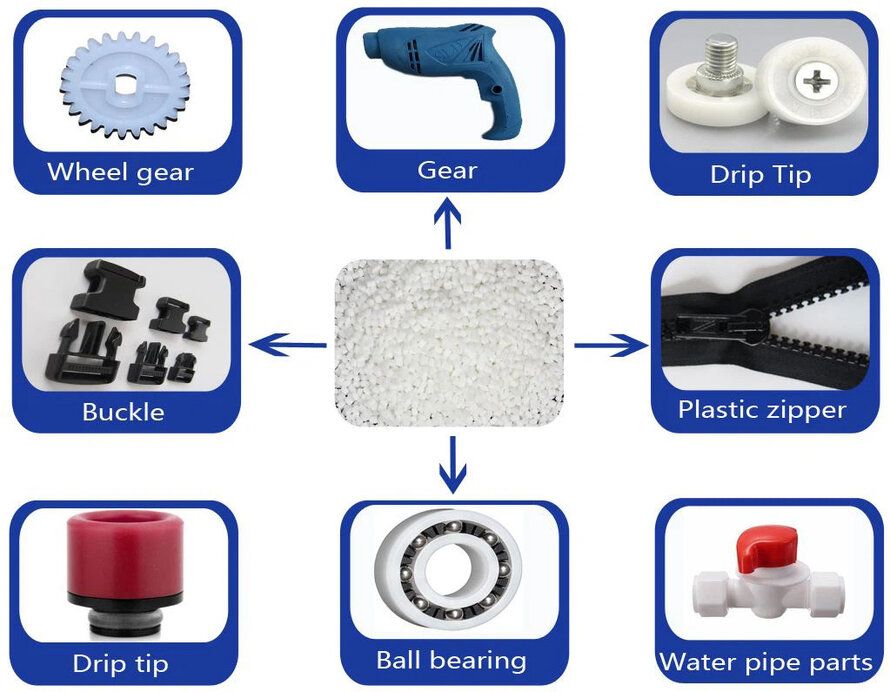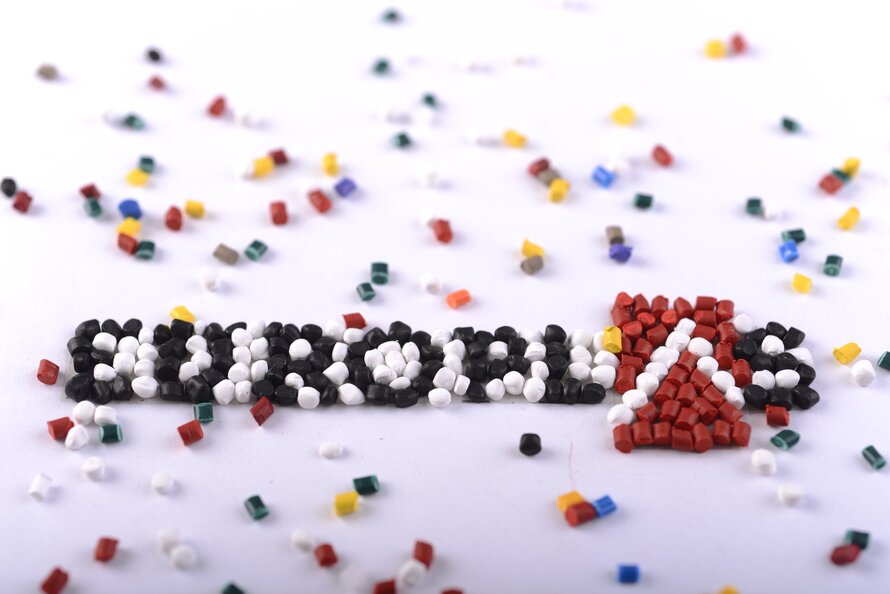POM material, also known as acetal, is a high-performance engineering thermoplastic renowned for its exceptional mechanical properties and versatility. Commonly utilized in precision parts requiring high stiffness, low friction, and excellent dimensional stability, POM plastic material has become a staple in various industries. This article delves into the advantages and disadvantages of POM material, shedding light on its suitability for different applications. By exploring both the strengths and limitations of POM, we will have a comprehensive understanding of why this material is a preferred choice for lots of areas.
1. Advantages of POM material
1.1. Tensile strength is higher than normal nylon, fatigue resistance, creep resistance
POM material exhibits a tensile strength that is significantly higher than that of standard nylon. This high tensile strength enables POM to withstand greater loads and stresses without deforming. Additionally, POM has excellent fatigue resistance, meaning it can endure repeated stress cycles without significant wear or failure.
Its creep resistance ensures that POM maintains its shape and structural integrity under long-term loads, preventing permanent deformation. These properties are crucial for components like gears, bearings, and conveyor belts that are subject to continuous or cyclic loading conditions.
1.2. Good dimensional stability
One of the standout properties of POM plastic material is its excellent dimensional stability. POM components maintain their precise dimensions and shape under a wide range of environmental conditions, including changes in temperature and humidity. This stability is essential for applications that require high precision and tight tolerances, such as automotive parts, aerospace components, and intricate engineering devices. POM's low thermal expansion rate further ensures that parts remain dimensionally stable and function reliably.
1.3. Water absorption is smaller than nylon
POM has a significantly lower water absorption rate compared to nylon, which is prone to absorbing moisture and swelling. This low water absorption ensures that POM material retains its mechanical properties, dimensional accuracy, and stability even in humid or wet environments. This characteristic is particularly beneficial for components used in plumbing, fluid handling systems, and environments with high humidity, where maintaining structural integrity is essential.
1.4. Good dielectric properties
POM's
dielectric properties make it an outstanding insulator for electrical and electronic applications. It has high insulation resistance and a low dielectric constant, which helps prevent electrical leakage and ensures the efficient operation of electrical components. These properties make POM ideal for use in connectors, switchgear, and other electrical insulators where reliable performance and safety are paramount.
1.5. High thermal stability and can be used normally at 120°C
POM can be used effectively in a wide temperature range, from -50°C to 120°C, without losing its mechanical properties. Its high thermal stability allows it to perform reliably under moderate heat without decomposing or softening. This makes POM suitable for components that are exposed to varying temperatures, such as automotive engine parts, hot water valves, and other high-temperature applications where consistent performance is required.
1.6. Small friction coefficient
The low coefficient of friction in POM reduces frictional forces between moving parts, leading to less wear and tear and extending the lifespan of the components. POM’s self-lubricating properties mean that it requires minimal maintenance and can operate smoothly in applications involving sliding or rotating parts. This makes it an excellent material for use in sliding bearings, seals, and other applications where reduced friction is essential for performance and durability.
1.7. Excellent elasticity, similar to spring action
POM material exhibits excellent elasticity, providing a spring-like action that allows it to absorb and recover from impacts without permanent deformation. This resilience is beneficial in applications that require a combination of rigidity and flexibility, such as flexible joints, resilient mounts, and components that need to absorb shocks or vibrations.
1.8. Chemical resistance
POM plastic material exhibits exceptional resistance to a wide range of chemicals, solvents, and fuels. It can endure exposure to oils, greases, alcohols, and many organic compounds without significant degradation. This makes POM ideal for applications involving frequent chemical contacts, such as fuel system components, pump parts, and seals.
1.9 Easy machinability
POM plastic is renowned for its excellent machinability, allowing for efficient and precise manufacturing processes. It can be easily shaped, milled, turned, and drilled, facilitating the production of complex designs and intricate parts. This makes POM material a preferred material for applications requiring high precision and intricate geometries, reducing production time and costs.
2. Disadvantages of POM material

What limitations does POM material possess?
2.1. High moisture absorption
Although POM plastic material has a lower moisture absorption rate compared to some nylons, it can still absorb moisture over time. This moisture uptake can negatively impact its dimensional stability and mechanical properties, potentially causing parts to swell, warp, or weaken. In applications where high dimensional accuracy and stability are critical, such as in precision mechanical parts, this characteristic may present challenges and necessitate additional design considerations.
2.2. Limited UV resistance
POM is prone to degradation when exposed to ultraviolet (UV) light for extended periods. This makes it less suitable for outdoor applications where prolonged sunlight exposure is expected. UV degradation can lead to discoloration, surface cracking, and a reduction in mechanical strength. To use POM in outdoor settings, UV stabilizers or protective coatings may be required, which can add to the material's cost and complexity.
2.3. Flammability
POM material is flammable and can ignite when exposed to an ignition source. This property limits its suitability for applications with stringent fire safety requirements. In environments where fire resistance is critical, such as in certain building materials, transportation, and consumer electronics, the flammability of POM poses a significant drawback. Alternatives with better fire-resistant properties might be necessary in such cases.
2.4. Brittleness at low temperatures
POM material can become brittle and more susceptible to cracking at low temperatures. This brittleness can lead to failure in applications exposed to cold environments, such as cold storage components. The material's reduced impact resistance at low temperatures must be considered during the design phase to ensure reliability and safety.
2.5. Difficult to paint and bond
Due to its low surface energy, POM material is challenging to paint and bond with adhesives. Paints and adhesives do not adhere well to its surface, often requiring special surface treatments or primers to improve adhesion. This characteristic complicates the manufacturing process and can increase production costs. In applications where aesthetic finishes or strong adhesive bonds are required, alternative materials that bond more easily may be preferable.
Read more: What is POM plastic? Key properties, benefits & applications
3. Brilliant applications of POM material

POM materials are widely used in many different fields and products
POM material is a versatile engineering thermoplastic known for its exceptional mechanical properties, dimensional stability, and resistance to wear. These characteristics make POM an ideal material for a wide range of applications across various industries.
3.1.Automotive Industry
In the automotive industry, POM plastic material is widely used due to its strength, dimensional accuracy, and oil resistance. It is found in fuel system components such as fuel rails, fuel pumps, and tank level sensors, where durability is crucial. Power steering and transmission casings also benefit from POM’s strength and stability.
Additionally, POM is used in windshield wiper gears, sunroof components, door handles, latches, pedals, and various interior trims and housings, all taking advantage of its low friction properties. Engine parts, including connecting rods and fasteners, also utilize POM for its resilience under high stress and temperatures.
3.2. Consumer electronics
In consumer electronics, POM plastic is valued for its excellent dimensional stability and low friction. It is used in precision components for cameras, laptops, and mobile phones, ensuring that these devices retain their accuracy throughout their service life.
POM plastic material is ideal for thin-walled connectors, battery compartments, sockets, and small housings that require tight tolerances. Its low friction properties make it suitable for buttons, dials, and sliders on various electronic devices.
3.3. Food contact applications
POM’s chemical resistance and FDA-compliant formulations make it a preferred material for food contact applications. It is used in conveyor belts and star wheels in food processing equipment, providing smooth operation and resistance to fats, oils, and acids. Dosing pumps and bottle caps benefit from POM’s precision and chemical resistance, while food chutes and funnels utilize its smooth, contaminant-free surface for handling food products.
3.4. Medical devices
In the medical field, POM’s biocompatibility, high purity, and ability to be sterilized open up numerous applications. It is used in inhalers and insulin pens for its precision and chemical resistance. Orthodontic brackets and surgical instruments benefit from POM’s mechanical properties and stability. Additionally, POM material components are found in cardiology equipment, kidney dialysis machines, and respiratory devices, where chemically inert parts are essential.
3.5. Industrial machinery
For industrial machinery, POM’s self-lubricating properties and resistance to wear make it ideal for moving parts. Bearings and bushings made from POM plastic material can withstand heavy loads and abrasive conditions. Gears and cams benefit from its high wear resistance, while conveyor rollers and lifters maintain consistent performance due to POM’s dimensional stability.
3.6. Domestic appliances
In domestic appliances, POM material is used for its resistance to household chemicals and reliable mechanical properties. Components in coffee makers, food processors, washing machines, dishwashers, and vacuum cleaners, such as impellers, pump rotors, buttons, and control knobs, all benefit from POM’s durability and smooth operation. POM bearings and gears in these appliances provide noise-free performance.
3.7. Other notable applications
Beyond these major industries, POM finds use in various unique applications. Low friction POM is ideal for zipper components, ensuring smooth movement. It is used in ballpoint pens for precision tips and ink delivery systems. Measuring and testing instruments benefit from POM’s stable frames and housings, ensuring accurate measurements. POM nuts and bolts in fasteners resist wear and maintain torque settings.
4. Conclusion
In conclusion, POM material stands out for its remarkable mechanical properties, making it a preferred choice for many engineering and industrial applications. While it offers numerous advantages such as high tensile strength, fatigue resistance, creep resistance, good dimensional stability, etc, it also has its share of disadvantages, including high moisture absorption, difficulty in painting and bonding, etc. Despite these challenges, the innovative applications of POM in areas like automotive, electronics, and consumer goods highlight its significant impact and potential. Understanding the balance of its benefits and limitations allows us to make informed decisions, leveraging POM's capabilities to achieve optimal performance in our projects.
5. About EuroPlas

EuroPlas brings quality and cost-effective plastic material solutions to your business
EuroPlas is proud to be a reliable plastic supplier for your projects, consistently aiming to provide customers with the most optimal material solutions in terms of both quality and cost. We offer a diverse range of materials, including bio-fillers, bioplastic compounds, plastic additives, color masterbatch, and filler masterbatch. As a trusted manufacturer with a proven track record, EuroPlas provides a comprehensive line of high-performance plastics.
EuroPlas continues to innovate and provide cutting-edge solutions to meet the evolving needs of the engineering industry, solidifying its position as a leader in the field of POM plastic engineering compounds. Visit the EuroPlas blog today to find countless useful insights about material knowledge, always updated with the latest and most reliable information.